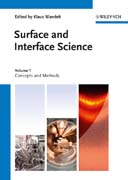
Surface and interface science v. 1, v. 2 Concepts and methods / Properties of elemental surfaces
Wandelt, Klaus
Covering interface science from a novel surface science perspective, this unique handbook offers a comprehensive overview of this burgeoning field.Eight topical volumes cover basic concepts & methods, elemental and composite surfaces, solid-gas, solid-liquid and inorganic-biological interfaces, as well as applications of surface science in nanotechnology, materials science and molecularelectronics.With its broad scope and clear structure, it is ideal as a reference for scientists working in the field, as well as an introduction for newcomers. INDICE: Volume 1Preface XIThe Editor XIIIList of Contributors XVAbbreviations XIX1 Introduction: An Intuitive Approach to Surface and Interface Science 1Klaus Wandelt1.1 Peculiarities of Surfaces 11.2 Importance of Surfaces and Interfaces 91.3 Summary 122 An Introduction to the Theory of Crystalline Elemental Solids and their Surfaces 13Angelos Michaelides and Matthias Scheffler2.1 Introduction 132.2 Some Basics 142.2.1 Crystalline Solids are Crystalline 142.2.2 Cohesive Energies 152.2.3 The Types’’ of Bonds in Solids 162.3 The ABC of DFT 182.3.1 Theoretical Framework 182.3.2 Approximations for Exchange and Correlation 212.3.3 Other Approximations and Practicalities of Condensed Phase DFT Calculations 242.4 Bonding in Solids 262.4.1 Bonding in Metals 262.4.2 Simple Metals and Jellium 282.4.3 Transition Metals and Tight Binding 292.4.4 DFT forthe Cohesive Properties of Metals? 312.4.5 Semiconductors and Covalent Bonding 332.4.6 DFT for the Cohesive Properties of Elemental Covalent Solids? 352.5 Surface Structure 372.5.1 Surface Relaxation 392.5.2 Surface Reconstruction 402.5.2.1 Reconstructions of Elemental Metal Surfaces 412.5.2.2 Reconstructions of Elemental Semiconductor Surfaces 432.5.3 Surface Structure Summary 492.6 Surface Energetics 492.6.1 Introduction and Experimental Considerations 492.6.2 Theoretical Considerations of Surface Energies 522.6.3 Phenomenological Theories of Surface Energies 532.6.3.1 Surface Energies and Cohesive Energies 532.6.3.2 Surface Energy Anisotropy 552.7 Surface Electronic Structure 572.7.1 Jellium Surfaces: Electron Spillout, Surface Dipole, and Work Function 572.7.2 Transition Metal Surfaces: Band Narrowing and Surface Core Level Shifts 612.7.3 Surface States 632.8 Conclusions and Perspectives 65Acknowledgments 67Further Reading 67References 683 Experimental Methods 733.1 Experimental Basics 73Marko Kralj and Klaus Wandelt3.1.1 The Surface Science Approach’’ 733.1.2 Physical Background of Vacuum 743.1.2.1 Introduction 743.1.2.2 The Ideal Gas 753.1.2.3 Gas Exposure 763.1.2.4 Pumping Concept 783.1.3 Technical Background of Vacuum Technology 803.1.3.1 Ultrahigh Vacuum Materials 803.1.3.2 Pumping Systems 813.1.3.3 Pressure Measurements 853.1.4 Sample Preparation 873.1.4.1 Preparation ofClean Surfaces 873.1.4.2 Controlled Adsorption and Deposition 893.1.5 SurfaceAnalytical Methods 90References 923.2 Electron Based Methods 933.2.1 Low-Energy Electron Diffraction (LEED) 93Klaus Heinz3.2.1.1 Historical Development 933.2.1.2 Basic Experimental LEED Equipment 963.2.1.3 Intensity Measurement 983.2.1.4 Surface Sensitivity 1003.2.1.5 The LEED Pattern and Intensity - its Formation and Information 1013.2.1.6 Multiple Scattering and Dynamical Intensities 1183.2.1.7 Tensor LEED 1303.2.1.8 Structure Determination 1363.2.1.9 PracticalLimitations and Direct Methods 145References 1493.2.2 Photoelectron Spectroscopy and Diffraction 151Jürg Osterwalder3.2.2.1 Introduction 1513.2.2.2 Instrumentation 1613.2.2.3 X-Ray Photoelectron Spectroscopy/Auger Electron Spectroscopy 1663.2.2.4 Ultraviolet Photoelectron Spectroscopy (UPS)/Angle-Resolved Photoemission Spectroscopy (ARPES) 1893.2.2.5 Spin-Polarized Photoelectron Spectroscopy 204References 210Further Reading 2143.2.3 Spectroscopic Databases and Standardization for Auger-Electron Spectroscopy and X-Ray Photoelectron Spectroscopy 215Aleksander Jablonski and Cedric J. Powell3.2.3.1 Introduction 2153.2.3.2 NIST Databases Relevant to Surface Sensitivity of AES and XPS 2183.2.3.3 Other NIST Databases 2383.2.3.4 Additional Data and Software for AES and XPS 2413.2.3.5 Standards for AES and XPS 2433.2.3.6 Summary 247References 2483.2.4 Two-Photon Photoelectron Spectroscopy 253Thomas Fauster3.2.4.1 Image-Potential States 2533.2.4.2 Energy-Resolved Spectroscopy 2563.2.4.3 Time-Resolved Measurements 2583.2.4.4 Experimental Setup 2623.2.4.5 Theoretical Aspects 264References 2673.3 Ion Scattering Spectroscopy 269D. John O’Connor3.3.1 Introduction 2693.3.2 Composition and Structure 2703.3.2.1 Element Identification 2703.3.2.2Concentration 2723.3.2.3 Structure 2753.3.3 Equipment 2763.3.4 Low-Energy IonScattering 2783.3.4.1 Composition Analysis 2783.3.4.2 Structure Analysis 2833.3.5 Medium-Energy Ion Scattering 2973.3.5.1 Composition Analysis 2983.3.5.2 Thin Layer Analysis 2983.3.5.3 Surface Crystal Structure, Reconstruction, and Relaxation 3003.3.6 Issues for Consideration 3043.3.6.1 Secondary Electron Emission 3043.3.6.2 Radiation Damage and Sputtering 3063.3.6.3 Macroscopic Damage 308References 3083.4 Photon-Based Methods 3113.4.1 Photon Spectroscopies 311Steve D. Barrett, Christopher A. Lucas, and Rasmita Raval3.4.1.1 Reflection-Absorption Infrared Spectroscopy (RAIRS) 3113.4.1.2 Ultraviolet-Visible (UV-vis) Absorption Spectroscopy 3433.4.1.3 Reflection Anisotropy Spectroscopy 3483.4.1.4 Near-Edge X-Ray Absorption Fine Structure (NEXAFS) 357References 3693.4.2 X-Ray Diffraction from Surfaces and Interfaces 375Elias Vlieg3.4.2.1 Introduction 3753.4.2.2 Basics of Diffraction 3763.4.2.3 Measuring Structure Factors 3923.4.2.4 Reflection and Refraction of X-Rays 3963.4.2.5 Data Analysis 4043.4.2.6Line Shapes 4113.4.2.7 Trends 421Acknowledgments 423References 4233.5 Scanning Probe Techniques 427Angelika K¨uhnle and Michael Reichling3.5.1 Introduction4273.5.2 Scanning Tunneling Microscopy 4283.5.2.1 Basic Principles and Apparatus 4283.5.2.2 Theory 4313.5.2.3 Capabilities 4353.5.2.4 Case Studies 4373.5.3Scanning Force Microscopy 4443.5.3.1 Basic Principles and Apparatus 4443.5.3.2 Theory 4543.5.3.3 Capabilities 4583.5.3.4 Case Studies 4603.5.4 Outlook 472References 474Volume 24 Surface Crystallography 489Klaus Heinz and Ulrich Starke5 The Electronic Structure of Metal Surfaces 561Erminald Bertel, Norbert Memmel, and AlexanderMenzel6 Electron Dynamics at Surfaces 637Thomas Fauster, Pedro M. Echenique and Evgueni V. Chulkov7 Surface Magnetism 679Marek Przybylski and J¨urgen Kirschner8 Dynamics at Surfaces 7438.1 Thermal Dynamics at Surfaces743Harald Brune8.2 Vibrations at Surfaces 773Wolf Widdra9 Surfaces of Elemental Semiconductors 815Michael Horn-von Hoegen10 Diamond Surfaces 889Lothar Ley and J¨urgen RisteinIndex 941
- ISBN: 978-3-527-41156-6
- Editorial: Wiley-VCH
- Encuadernacion: Cartoné
- Páginas: 1004
- Fecha Publicación: 14/03/2012
- Nº Volúmenes: 2
- Idioma: Inglés
